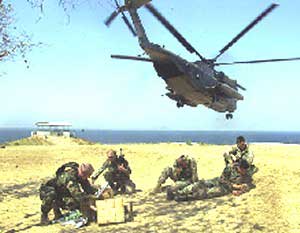| They will be supported by about 400 more
U.S. troops based to the north in the port city of Zamboanga.
It was not immediately clear how many Philippine
forces would be involved in the offensive.
In addition to the U.S. special operations
forces and the support personnel, a team of about 1,000 Marines aboard
Navy ships off the coast of the Sulu Archipelago will be available to respond
on short notice with air power, logistics help and medical aid.
The Marines are part of the Okinawa-based
31st Marine Expeditionary Unit, and their lead ship is the USS Essex, based
at Sasebo, Japan.
U.S. officials have said in recent days
that they have new information showing a stronger link than previously
believed between the Philippine rebels and other international terrorist
groups.
The government of Philippine President
Gloria Macapagal Arroyo said Monday that she had approved joint training
with U.S. forces on Jolo, where some Abu Sayyaf rebels fled after the previous
U.S.-Filippino effort last year to root them out of Basilan island, to
the north of Jolo.
U.S. officials said the next offensive,
to begin sometime in March at the Philippine government's choice, would
go well beyond training to include direct combat roles for U.S. forces.
The purpose, one official said, is to "disrupt
and defeat the Abu Sayyaf group." He said the effort had not time limit
and would continue as long as both governments agree it is needed.
There are believed to be several hundred
Abu Sayyaf rebels in the Philippines. Early this month the Philippine military
announced it had greatly underestimated the number of Abu Sayyaf and warned
it would take a long time to wipe them out.
A Department of National Defense report
submitted to the Philippine Congress late last year placed their strength
at 250, down from 800 in 2001. But Chief of Staff Gen. Dionisio Santiago
acknowledged Feb. 5 that a recheck of military documents and figures showed
a number closer to 500 - most on the impoverished island of Jolo.
Several terrorist groups, some with suspected
links to al-Qaida such as the Islamic extremist network Jemaah Islamiyah,
operate in the Philippines and there have been a series of deadly bombings,
kidnappings and other attacks against both government and civilian targets.
An Oct. 2 incident blamed on Abu Sayyaf killed three people, including
a U.S. Green Beret in the port city of Zamboanga.
Pentagon officials say investigations following
some of those attacks have turned up information indicating there may be
a stronger than earlier believed link between the Abu Sayyaf and the Jemaah
Islamiyah of Indonesia.

|
